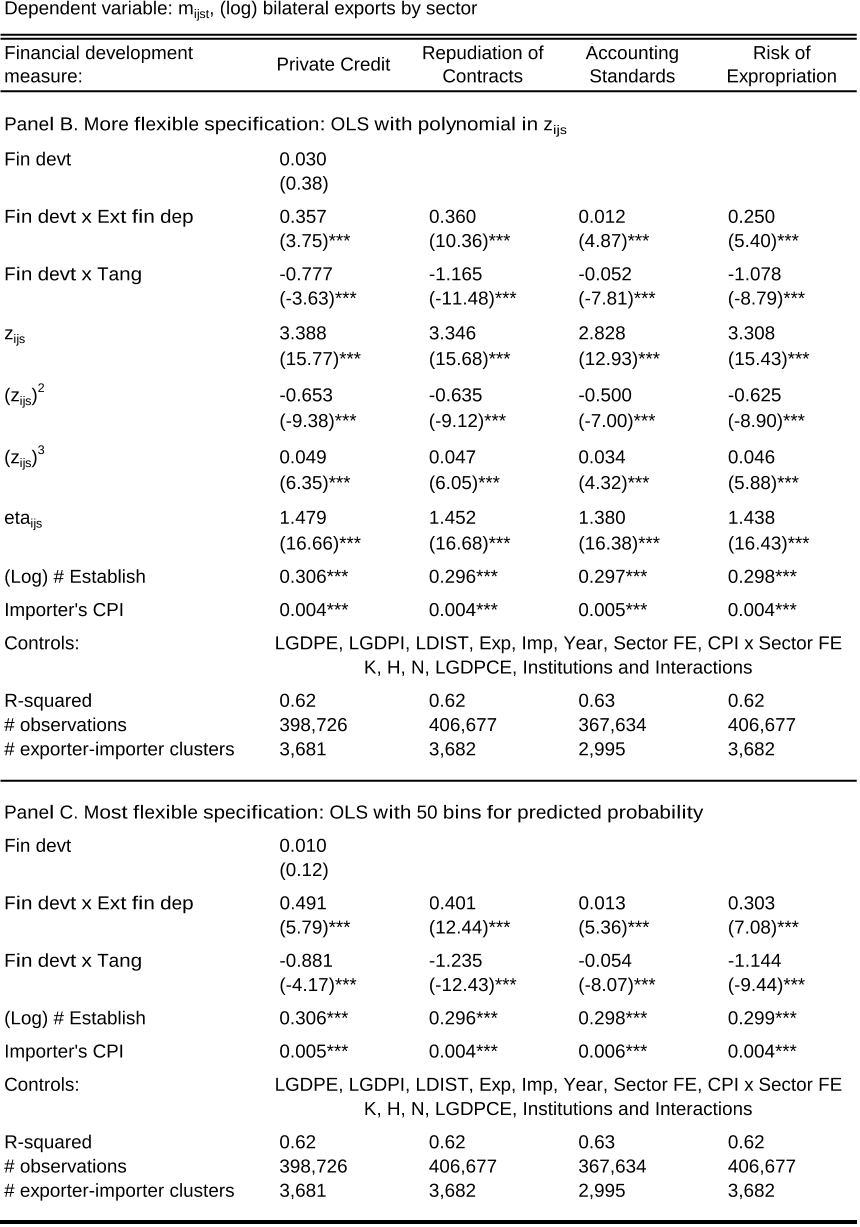Credit Constraints, Heterogeneous Firms and International Trade
Reads0
Chats0
TLDR
This article examined the detrimental consequences of financial market imperfections for international trade and developed a heterogeneous-firm model with countries at different levels of financial development and sectors of varying financial vulnerability.Abstract:
This paper examines the detrimental consequences of financial market imperfections for international trade. I develop a heterogeneous-firm model with countries at different levels of financial development and sectors of varying financial vulnerability. Applying this model to aggregate trade data, I study the mechanisms through which credit constraints operate. First, financial development increases countries' exports above and beyond its impact on overall production. Firm selection into exporting accounts for a third of the trade-specific effect, while two thirds are due to reductions in firm-level exports. Second, financially advanced economies export a wider range of products and their exports experience less product turnover. Finally, while all countries service large destinations, exporters with superior financial institutions have more trading partners and also enter smaller markets. All of these effects are magnified in financially vulnerable sectors. These results have important policy implications for less developed economies that rely on exports for economic growth but suffer from poor financial contractibility.read more
Figures

Table 10. Economic Significance: Predicted vs. Actual Trade Growth 
Table 9. Economic Significance: Comparative Statics 
Table 5. Financial Development and Firm-Level Exports 
Figure 3. The Productivity Cut-off for Exporting 
Table 5. Financial Development and Firm-Level Exports 
Table 1. Export Patterns in the Data
Citations
More filters
Export Dynamics, Success and Efficiency: Micro-level Evidence from Bangladesh (2004-05 to 2011-12)
TL;DR: In this paper, the authors present a list of tables and figures of figures in the form of a table and a figure graph for each of the tables and the figures of the figures.
Journal ArticleDOI
Destination country financial development and margins of international trade
Xiaohan Ma,Weisi Xie +1 more
TL;DR: In this paper, the authors demonstrate theoretically and empirically that financial development of the destination country is as important as that of the origin country in shaping bilateral trade patterns, on both the extensive margin and the intensive margin of international trade.
Nexus between Financial Development, Agriculture Raw Material Exports, Trade Openness and Economic Growth of Pakistan
TL;DR: In this article, the authors evaluated the role of financial development, agriculture raw materials and the extent of openness to trade in economic development of Pakistan for the period 1980-2012, by using Vector Auto Regressive (VAR) model.
Journal ArticleDOI
Financial intermediation, trade agreements and international trade*
TL;DR: In this paper, the authors used a gravity model on a data set of 69 developed and developing countries over the period 1986-2006 to show that the trade-promoting role of financial intermediation in the exporting country is mitigated when this country faces low exporting costs, that is when there is a regional trade agreement (RTA) between this country and the importing one.
Journal ArticleDOI
Global sourcing and credit constraints
TL;DR: In this paper, credit constraints are incorporated into a model of global sourcing and heterogeneous firms, and the model predicts that increased financial development decreases the share of integration relative to outsourcing in a country.
References
More filters
Posted Content
Law and Finance
Rafael La Porta,Rafael La Porta,Florencio Lopez de Silanes,Florencio Lopez de Silanes,Andrei Shleifer,Andrei Shleifer,Robert W. Vishny,Robert W. Vishny +7 more
TL;DR: This paper examined legal rules covering protection of corporate shareholders and creditors, the origin of these rules, and the quality of their enforcement in 49 countries and found that common law countries generally have the best, and French civil law countries the worst, legal protections of investors.
Journal ArticleDOI
Law and Finance
TL;DR: In this article, the authors examined legal rules covering protection of corporate shareholders and creditors, the origin of these rules, and the quality of their enforcement in 49 countries and found that common-law countries generally have the strongest, and French civil law countries the weakest, legal protections of investors, with German- and Scandinavian-civil law countries located in the middle.
Journal ArticleDOI
The Impact of Trade on Intra-Industry Reallocations and Aggregate Industry Productivity
TL;DR: This paper developed a dynamic industry model with heterogeneous firms to analyze the intra-industry effects of international trade and showed how the exposure to trade will induce only the more productive firms to enter the export market (while some less productive firms continue to produce only for the domestic market).
Journal ArticleDOI
Finance and Growth: Schumpeter Might Be Right
TL;DR: In this paper, the authors examined a cross-section of about 80 countries for the period 1960-89 and found that various measures of financial development are strongly associated with both current and later rates of economic growth.
ReportDOI
Financial Dependence and Growth
Raghuram G. Rajan,Raghuram G. Rajan,Raghuram G. Rajan,Luigi Zingales,Luigi Zingales,Luigi Zingales +5 more
TL;DR: This paper examined whether financial development facilitates economic growth by scrutinizing one rationale for such a relationship; that financial development reduces the costs of external finance to firms, and found that industrial sectors that are relatively more in need of foreign finance develop disproportionately faster in countries with more developed financial markets.